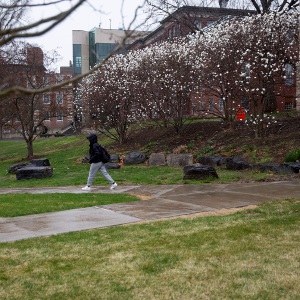Tropical Storm Irene, 10 years later: Preventing the next Irene, or at least the catastrophic flooding
| Published: 08-28-2021 9:27 PM |
In the wake of Irene, Vermont nonprofits, state agencies and residents have worked together to make their communities more resilient as climate change threatens to unleash more extreme weather.
Planting a tree may seem like an insignificant act when strategizing how to defend against a storm that may spread over 500 miles of land and turn a babbling brook violent.
But Mary and Greg Russ argue that trees should be at the center of any flood resilience plan. The Sharon couple heads the White River Partnership, a nonprofit committed to a healthy watershed that has been planting trees along the river since 1996.
“We noticed that places where we planted trees got through Irene without a lot of erosion,” said Mary Russ, executive director of the South Royalton-based organization.
Her husband, Greg, is the nonprofit’s monitoring coordinator. He listed the varied benefits of planting trees along riverbanks: They keep the river cool, offer shade and provide aquatic life with food. In a flood, he said that trees function as “speed bumps.”
“There’s this misconception that you want to get the water out fast,” he said. “But speed increases the erosive power of the river. What you want to do is slow it down and take the power out. If you take the power out, there’s less erosion.”
The partnership helps landowners plant “riparian buffers” of native shrubs, trees and perennials along their riverbanks and conserve open land along rivers to allow overflow without damaging infrastructure. After Irene, the group also established a culvert replacement project, which replaced 10 culverts in Rochester and Hancock, Vt., over the last seven years and has worked to conserve the fields that were underwater during Irene.
Without a buffer, a river may erode the surrounding land when a large storm hits — just as farmers who lost chunks of their fields to Irene saw firsthand.
Article continues after...
Yesterday's Most Read Articles
 Football helmet maker buys Lebanon’s Simbex
Football helmet maker buys Lebanon’s Simbex
 James Parker granted parole for his role in Dartmouth professors’ stabbing deaths
James Parker granted parole for his role in Dartmouth professors’ stabbing deaths
 Zantop daughter: ‘I wish James' family the best and hope that they are able to heal’
Zantop daughter: ‘I wish James' family the best and hope that they are able to heal’
 Kenyon: Dartmouth alumni join union-busting effort
Kenyon: Dartmouth alumni join union-busting effort
 Parker up for parole more than 2 decades after Dartmouth professor stabbing deaths
Parker up for parole more than 2 decades after Dartmouth professor stabbing deaths
 Through new school partnerships, CRREL seeks to educate young scientists
Through new school partnerships, CRREL seeks to educate young scientists
Still, as Greg Russ sees it, erosion is natural: Rivers are meant to roam, and Irene served as a “geological reset button” that attempted to make up for centuries of constraints in just a few hours. Streams that had been cut off from their flood plains for centuries broke their banks and rambled freely.
When unfettered by human infrastructure, rivers carve out new channels at will. The partnership’s goal is to give “the river the room it needs to respond to the climate we’re experiencing,” Mary Russ said. When a river can safely fill its flood plain, it slows down, lessening destruction for everyone downstream.
Irene was one of a procession of tropical storms that have left their stamp on the Upper Valley over the centuries, but it also bore the marks of a warming climate.
“As storms are curving along the eastern seaboard, most of New England actually is in the path for those systems,” said Lesley-Ann Dupigny-Giroux, a climatologist at the University of Vermont and the state climatologist, a fact borne out in warnings about Henri earlier this month, even though only a moderate rain fell on the Upper Valley.
The Great Vermont Flood of 1927, the closest comparison to Irene, established many of the records still standing in each of the Twin States today. Looking backward can prove prescient. The hotspots of pronounced damage had barely shifted between 1927 and 2011, Dupigny-Giroux said. Roads along rivers were vulnerable then, and they are vulnerable now.
“Storm systems are probably bigger (now),” said Dupigny-Giroux. “There may not be as many of them, but they do produce more precipitation.”
Hurricanes are “heat engines,” she notes. They need the warm water along the Atlantic Gulf Stream and the coasts to fuel their ascent northward. As ocean temperatures climb, they add fire to hurricanes’ fury.
Dupigny-Giroux listed a range of shifts in tropical storms as climate change accelerates: They encompass a far greater area; they drop more rain than hurricanes of the past; and they move slowly, and so the deluges where they linger are worse.
Irene held true to those trends. It sprawled across a 500-mile diameter, dropped as many as 8 inches of rain in parts of Vermont and stalled over the Hudson and Connecticut river valleys for nearly seven hours before edging north.
Storms of Irene’s magnitude are rare, making them hard to predict.
Although dubbed a “hundred-year storm,” that does not mean that the Upper Valley is safe for another 90 years.
“If conditions are right, you could get two 500-year storms — several of them — in the same year,” Dupigny-Giroux said.
The rivers that form a spidery web across the Upper Valley once roamed more freely over their flood plains. Then they became the veins of New England’s industrial and transportation systems, and were transformed to meet that purpose. Dams were built to capture the rivers’ energy, and waterways were channelized so boats could pass.
“Dig them straight” was the philosophy of river management at the turn of the 20th century, according to Mary Russ.
The more aggressively bulldozers and dynamite straightened the rivers, the faster they flowed and the more violently they flooded.
“More than 200 years ago with colonization of Vermont, our river channels were channelized; they were straightened for agriculture, for forestry, for power, for all sorts of reasons,” said Gretchen Alexander, a river scientist with the Vermont Agency of Conservation. “Rivers were often pushed to one side of the valley or another, and then sometimes a road was put right next to the river to keep it pinched between the edge of the valley and a road, or sometimes a railroad.”
In that process, many rivers became disconnected from their flood plains. With no room to spill over their banks, those rivers eroded deeper into the valley, Alexander said. Unable to discharge in their flood plains, rivers gain more and more energy, making floods so destructive that they can sweep away vulnerable infrastructure. Only floods of the greatest magnitude, like those during Irene, are able to surmount the riverbanks at all.
Alexander’s department works with the White River Partnership and other local groups to restore the natural riparian landscape. The Vermont Agency of Conservation considers rivers in terms of wide “corridors” that leave room to flood and move, instead of narrow channels.
“Our philosophy around rivers is that these are dynamic systems that change over time and we need to treat them as such, and to the extent that we’re able to, keep our investments out of harm’s way,” Alexander said.
In the last 15 years, her agency has secured over 100 river easements. Instead of straight-jacketing a river with riprap or armoring, the agency plants buffers of native plants and secures open flood plains.
Alexander described the easements as “insurance” against an unpredictable climate.
The destruction after Irene “provided an opportunity to highlight the importance of that approach,” she said. Especially hard-hit communities became committed to giving their rivers more room and preparing for the next flood.
In Bethel, Irene swept away riverside homes and left behind debris and muck on the normally picturesque streets.
The town is “unique in terms of the concentration of easements,” she said. It has five in total. Several are immediately upriver from the town’s center and would dissipate the energy of a supercharged river before it has the chance to decimate the homes and businesses clustered in the village.
The Bethel Conservation Commission spent years fighting a proposal to build a Dollar General discount store on a parcel of land along the White River and across from the town’s fire station.
“It would have had lots of impermeable surfaces, which would have displaced that flood plain to everywhere else,” said Ferron Griffin, who co-chairs the conservation commission. “Impermeable surfaces” includes asphalt, concrete and other materials that do not absorb runoff.
“We went to every meeting that we could, we gave our opinion and tried to give as much data as possible, and also we brought some help with us,” Griffin said.
Representatives from the partnership and a scientific consultant provided their expertise. Last year, they finally defeated the proposal. The town bought the land, and will open a new park — Carla’s Meadow — this fall.
“The best and worst thing that happened to Vermont was Tropical Storm Irene,” said Jennifer Gilbert, of the New Hampshire Office of Energy and Planning. “They have a really great flood plain program. New Hampshire wasn’t as impacted.”
Gilbert has been the state’s coordinator for the National Flood Insurance Program since 2005.
Since Irene, the Federal Emergency Management Agency, better known as FEMA, administered federal flood insurance. FEMA has released new flood plain maps for much of New Hampshire. The maps dictate flood insurance rates, and new insurance guidelines will be released this fall.
Gilbert expressed some frustration with FEMA’s mapping process, which does not account for how quickly river channels can move. The new maps are based on surveys that were already out of date when they were published.
Even the most detailed and well-researched map cannot provide certainty. Gilbert emphasized that any homeowner can buy flood insurance, whether or not they live in a federally designated flood plain.
“Mother Nature doesn’t read maps,” Gilbert said. “Just because there’s a line there doesn’t mean the flood is going to stop there.”
FEMA is changing how the National Flood Insurance Program evaluates risk across all 50 states. “Risk Rating 2.0” is a more “equitable” model that will mean more people will be “paying for their risk,” Gilbert said. The new pricing methodology — which has not been updated for 50 years — will consider the land around a given structure rather than just the structure itself, as well as distance from a water source, the impact of heavy rainfall and other variables.
Risk Rating 2.0 may discourage construction in flood-prone areas — insurance rates that more accurately evaluate risk may heavily disincentivize building on vulnerable land. Some homeowners will also be able to reduce their insurance rates through “mitigation efforts,” like elevating a foundation.
Gilbert encourages the communities she works with to limit development in areas that may be underwater when a heavy storm comes. The only guaranteed way to keep infrastructure dry during a flood is to build it on high ground.
Claire Potter is a Report for America corps member. She can be reached at cpotter@vnews.com or 603-727- 3242.

 Art Notes: After losing primary venues, JAG Productions persists
Art Notes: After losing primary venues, JAG Productions persists  Over Easy: Marvels in the heavens, and in the yard
Over Easy: Marvels in the heavens, and in the yard  Amid financial difficulties, Lebanon-based Revels North cancels midwinter show
Amid financial difficulties, Lebanon-based Revels North cancels midwinter show  Art Notes: The Pilgrims to perform ‘last’ show Saturday in Hanover
Art Notes: The Pilgrims to perform ‘last’ show Saturday in Hanover
